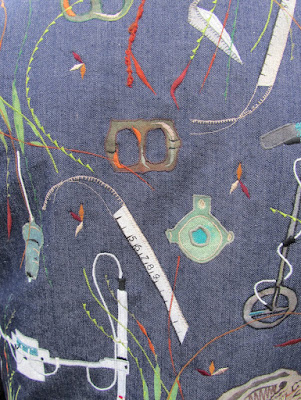Starting a small creative business. Those early days.
I first opened my studio 1991 at Cockington Court, Torquay. Having a studio at Cockington Court with the Devon Rural Skills Trust enabled people to see me working, demonstrate and commission work in person.
 |
| Studio at Cockington Court 1991 |
Working in a studio environment with other craftspeople around was great fun and incredibly inspiring. It was great to bounce ideas and hear first hand reports of creative opportunities. Having the general public walk through the studio all day took some getting used too. Patterns formed with comments made. The first word uttered would become a predictable sentence, such as "how" and I would know the following words would be "did it take you to make that", or "you" and "must have good eyesight to do that". Sentences referring to the word "patience" were incredibly frequent. My Fibonacci Quilts in particular took quite a bit of explaining and very time consuming. After a while I typed a sheet of "frequently asked questions", covered it with plastic and attached it to the table. It was easy then to point to the information smile and carry on working.
One of the most memorable moments was when my studio was full of people and I was giving my usual spiel on Fibonacci. Having repeated this mantra many times I basically felt like a monkey in a zoo with all these people staring at me. After a while I became aware of someone in the audience who looked very familiar, and in a dumb sort of way I sort of associated him with my then American boyfriend. This person asked me loads of questions about my work. The buzz later in the building was that a world famous actor had walked through unrecognised. I checked out a picture, and yes, it was him. Oh, my goodness!!
 |
| Studio at Cockington Court 1991 |
Sometimes a member of the public would come out with a real nugget of useful information. One of the best bits of advice I ever received was from a gentleman who had some knowledge of the Italian Murano Glass industry. He looked thoughtfully at all my work and said I must start producing smaller, cheaper products to earn a "bread and butter" income, as long term I would not be able to rely on commissions, teaching and selling my signature works. Hand sewing would never give me a living wage. This was really hard to accept, but he was right I and started to diversify by creating kits, fabric parcels, and waistcoats. This advice maybe obvious but at the time I was so passionate about sewing by hand and producing signature pieces that compromise was not an option.
When I look back at those days I wondered how I survived, being single I had to support myself with accommodation, studio rent, electricity, water rates and council tax bills to pay. Plus food. My mother used to take me to the supermarket one day a week which was very helpful. No mobiles, cars, internet, insurance, loans or other costly items. I cycled everywhere and kept life very simple indeed. It was a very happy existence...........then came the internet.........
My next blog will be about how the Internet changed my creative life.




